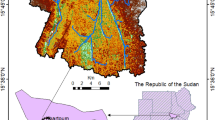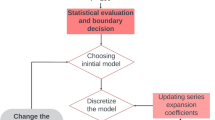Abstract
The Kozeny–Carman equation has achieved widespread use as a standard model for estimating hydraulic conductivity of aquifers. An empirically modified form applicable in shallow formations called Csókás’ formula is discussed, which is based on the relation between the effective grain-size and formation factor of freshwater-bearing unconsolidated sediments. The method gives a continuous estimate of hydraulic conductivity along a borehole by using electric and nuclear logging measurements without the need of grain-size data. In the first step, synthetic well-logging data sets of different noise levels are generated from an exactly known petrophysical model to test the noise sensitivity of the Csókás’ method and to assess the degree of correlation between the results of Csókás’ and Kozeny–Carman model. In the next step, borehole logs acquired from Hungarian sites are processed to make a comparison between the Csókás’ formula and the Kozeny–Carman equation including grain-size data measured on rock samples. The hydraulic conductivity logs derived separately from the Csókás’ and Kozeny–Carman formulae show reliable interpretation results, which are also validated by the Hazen’s formula and statistical factor analysis. The fundamental goal of Professor Csókás’ research was to derive some useful hydraulic parameters solely from well-logging observations. This idea may be of importance today since the input parameters can be determined more accurately by advanced measurement techniques. Hence, the Csókás’ formula may inspire the hydrogeophysicists to make further developments for a more efficient exploration of groundwater resources.




Similar content being viewed by others
References
Alberty M, Hashmy K (1984) Application of ULTRA to log analysis. In: SPWLA symposium transactions, Paper Z, pp 1–17
Alger RP (1971) Interpretation of electric logs in fresh water wells in unconsolidated formation. SPE Reprint Series vol 1, p. 255
Archie GE (1942) The electrical resistivity log as an aid in determining some reservoir characteristics. SPE, Trans AIME 146(1):54–62
Bartlett MS (1953) Factor analysis in psychology as a statistician sees it. In: Nordisk Psykologi’s 456 Monograph 3. Almqvist and Wiksell, Uppsala, pp 23–34
Bear J (1972) Dynamics of fluids in porous media. Dover Publications Inc., New York
Carman PC (1937) Fluid flow through granular beds. Trans Inst Chem Eng 15:150–166
Csókás J (1995) Determination of yield and water quality of aquifers based on geophysical well logs (in Hungarian). Magy Geofiz 35(4):176–203
Dobróka M, Szabó NP (2011) Interval inversion of well-logging data for objective determination of textural parameters. Acta Geophys 59:907–934
Gálfi J, Liebe P (1981) The permeability coefficient in clastic water bearing rocks (in Hungarian). Vízü Közl 63(3):437–448
Glover PWJ, Walker E (2009) Grain-size to effective pore-size transformation derived from electrokinetic theory. Geophysics 74(1):E17–E29
Hazen A (1892) Some physical properties of sands and gravels. Annual Report. Massachusetts State Board of Health, Boston, pp 539–556
Jarzyna JA, Krakowska PI, Puskarczyk E, Wawrzyniak-Guz K, Bielecki J, Kwiatek WM, Gruszczyk M (2012) Spatial distribution of petrophysical properties on the basis of laboratory results, well logging and seismic data. Geosci Eng 1(2):87–92
Jöreskog KG (2007) Factor analysis and its extensions. In: Cudeck R, MacCallum RC (eds) Factor analysis at 100, Historical developments and future directions. Lawrence Erlbaum Associates, New Jersey
Juhász J (2002) Hidrogeology (in Hungarian). Akadémiai Kiadó, Budapest
Kirsch R (ed) (2009) Groundwater geophysics. A tool for hydrogeology, 2nd edn. Springer, Berlin
Kovács G (1972) Hydraulics of filtration (in Hungarian). Akadémiai Kiadó, Budapest
Kozeny J (1927) Ueber kapillare Leitung des Wassers im Boden. Sitzungsber Akad Wiss 136(2a):271–306
Larionov VV (1969) Radiometry of boreholes (in Russian). Nedra, Moscow
Lawley DN, Maxwell AE (1962) Factor analysis as a statistical method. Statistician 12:209–229
Ogbe D, Bassiouni Z (1978) Estimation of aquifer permeabilities from electric well logs. Log Anal 19(5):21–27
Pirson SJ (1963) Handbook of well log analysis. Prentice-Hall Inc., New York
Puskarczyk E, Jarzyna J, Porebski SJ (2014) Application of multivariate statistical methods for characterizing heterolithic reservoirs based on wireline logs—example from the Carpathian Foreland Basin (Middle Miocene, SE Poland). Geological Quarterly, in press
Rubin Y, Hubbard SS (2005) Hydrogeophysics. Water Science and Technology Library Series, vol 50. Springer, Dordrecht
Sallam O. M. 2006: Aquifers parameters estimation using well log and pumping test data, in arid regions—step in sustainable development. In: The 2nd international conference on water resources and arid environment, 26–29 Nov, Riyadh, pp 1–12
Szabó NP (2011) Shale volume estimation based on the factor analysis of well-logging data. Acta Geophys 59(5):935–953
Szabó NP, Dobróka M (2013) Extending the application of a shale volume estimation formula derived from factor analysis of wireline logging data. Math Geosci 45(7):837–850
Szabó NP, Dobróka M, Turai E, Szűcs P (2014) Factor analysis of borehole logs for evaluating formation shaliness: a hydrogeophysical application for groundwater studies. Hydrogeol J 22:511–526
Zilahi-Sebess L, Fancsik T, Török I, Kovács AC (2007) The possibilities of estimating hydraulic conductivity based on geophysical measurements (in Hungarian). Magy Geofiz 48(3):99–111
Acknowledgments
The first author as the leading researcher of OTKA project no. PD-109408 thanks to the support of the Hungarian Scientific Research Fund as well as to the support of the János Bolyai Research Fellowship of the Hungarian Academy of Sciences. The third author as the leading researcher of OTKA project no. K-109441 thanks to the support of the Hungarian Scientific Research Fund. The investigation was partly based on the previous research work of the TÁMOP (project No. 4.2.1.B-10/2/KONV-2010-0001) Center of Excellence. The described work was carried out as part of the TÁMOP-4.2.2.A-11/1/KONV-2012-0049 project in the framework of the New Hungarian Development Plan. The realization of this project is supported by the European Union, co-financed by the European Social Fund (as a support for the second author). The authors thanks to László Hursán titular associate professor of the Department of Geophysics in University of Miskolc for the professional consultation on well-site applications.
Author information
Authors and Affiliations
Corresponding author
Rights and permissions
About this article
Cite this article
Szabó, N.P., Kormos, K. & Dobróka, M. Evaluation of hydraulic conductivity in shallow groundwater formations: a comparative study of the Csókás’ and Kozeny–Carman model. Acta Geod Geophys 50, 461–477 (2015). https://doi.org/10.1007/s40328-015-0105-9
Received:
Accepted:
Published:
Issue Date:
DOI: https://doi.org/10.1007/s40328-015-0105-9




